Float fishing Part 2
- Details
- Published on Tuesday, 31 July 2007 08:52
- Written by Richard Maurins
 There are many books written on the art of fishing with a float and it’s fair to say I guess to “game” anglers they are of little or no interest, I’ll assume that most of you haven’t read them avidly from cover to cover, but you have an understanding of the course fishers dark art.
There are many books written on the art of fishing with a float and it’s fair to say I guess to “game” anglers they are of little or no interest, I’ll assume that most of you haven’t read them avidly from cover to cover, but you have an understanding of the course fishers dark art.
I’ll carry on from where I left it in the first article with presentation and the reasons why I came to my decision. You will have to modify this to suit the variables in your fishing. Strength of river current and depth of swim obviously affect how you present, along with wind speed and direction. Colour of the water, how bright a day is it? familiar , it should be as it’s exactly what we all do prior to casting a fly.
Bait
What you choose is often out of personal preference, how easy is it to obtain is often the key. Old books talk of macaroni and rice, real flies and big black slugs as bait, when did you last catch a live daddy long legs and use it for bait?. You should at least think about it, fishing on mixed species rivers I’ve caught trout and grayling float fishing for chub and barbel with large slugs and lumps of luncheon meat that would choke a donkey (alright the grayling didn’t like the slugs).
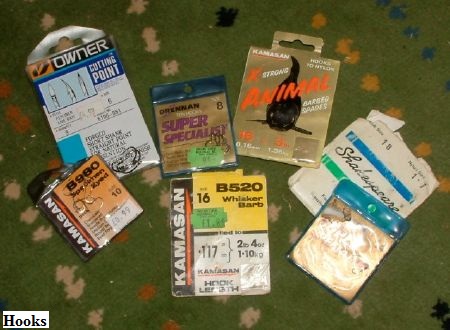 Hooks
Hooks
I always choose the hook to use after I’ve decided on the bait and there are bewildering ones to choose from. Again personal choice - confidence is the key, if you are comfortable with a given type, stick with it. I like forged hooks that are flattened, as an engineer I understand the added strength this gives to the wire, not fussed with chemical sharpening as I often change hooks during the course of the day and don’t re-use hooks.
The size of hook you choose is governed by the bait and not the size of fish, we as fly anglers know this, a low water salmon hook is hopefully going to deceive just as large a salmon as is a huge treble on a toby.
As a general rule of thumb the bait should weigh more than the hook, so a small worm or maggot is presented on nothing larger than size 16 and so on. In smaller sizes I use spade end patterns just because the whip knot is tidier. Plenty of good ones already tied if you want them.
The photo shows a typical selection of hooks for a days fishing with bait.
Line
Even more bewildering choices, personally I keep away from the ultra thin “stretched” lines as they tend to be brittle. For float fishing I like it to float be it winter or summer purely because of personal preference. 4 pound breaking strain for my reel line is standard and down to 1.5lbs for the hook length.
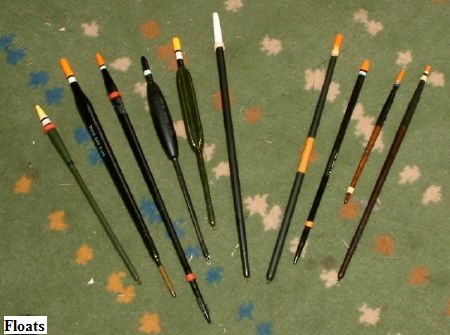 Floats
Floats
I have never seen so many “bubble” floats in my life as I’ve seen in the past year in and around Scotland, they are extinct everywhere else. I cannot think of one instance where these would be my choice of “weapon”.
A float's purpose is to present the bait and give a visual indication of a “bite”, it should be offering as little in the way of resistance to a feeding fish as is possible and should be able to be controlled to give the bait the best chance of deceiving the quarry, a bubble fails on all these points.
This photo shows stick floats, the ones on the left are shouldered types for stret pegging or larger baits in heavier water. The ones on the right are for trotting, note the 2 end ones are made of different materials, the lower section of heavy wood like lignum, which both reduces the number of weights required and the way the float “swims” the water.
Rod and Reel
A nice tip action rod to act as a shock absorber to the light line is required, I suggested that carbon fibre or something similar is probably desirable as they are so much lighter than glass or cane. I do have a cane rod but it’s now more of an ornament than a working tool these days, same applies to my first fly rod also of cane construction.
I prefer a centrepin type reel and the following will demonstrate why.
Method
I prefer to use the “stick” float method rather than “waggler” style on moving water, some will argue against, but I like to have the closer control that the stick offers. Two basic methods are used, trotting and stret pegging. Both use identical equipment except for the positioning of the float and shot.
Stick float method is trotting through at basically the same pace as the flow of the river, whereas stret pegging is holding the tackle back against the flow. Stick float fishing is normally set up so that the hook and bait just “trip” along the bottom, lifting tantalisingly when you slow the travel by just slowing down the flow of line (easier with a centrepin).This is improved by placing the split shot on the line in what is described as “shirt button “ style, i.e. equally spaced out from the bottom of the float to the start of the hook link, ideal method when using maggots, small worms and naturals like water shrimps, caddis larvae etc. It even works with buzzer patterns and leaded nymphs.
Stret pegging is where the float is set slightly deeper than the water with the hook link on the bottom. To aid this the shot are bunched together just above the hook link, here you hold the float back with the bait stopping for a while and then released a bit further down the river.
Both of these methods are better done standing at the waters edge or if needed in the water, this both aids float control and feeding the swim with “loose feed”. For me both methods are done with the line tight to the float from the tip of the rod, only touching the water if on a long trot, which is why I find the centrepin easier than an open fronted “spinning type reel, it’s personal preference.
So now we have the basics, you arrive at the swim, with the cunning of years of water craft you pick a likely spot. Well off the sky line you set up the tackle and creep into place, trot the gear through without any bait to check the depth and then bait up and start fishing, throwing in loose offerings of your hook bait and proceed to empty the river………….well we can dream.
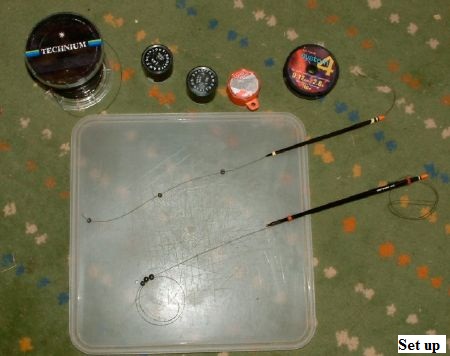 In this photo: the top example is “shirt button” shot pattern for trotting the stream and the lower is “bunched” for stret peg style. Note that I use rubber bands “top and bottom”, don’t pass the line through the ring at the bottom , if one is fitted. If you wish to change float with this method you don’t have to break the line to get the float off.
In this photo: the top example is “shirt button” shot pattern for trotting the stream and the lower is “bunched” for stret peg style. Note that I use rubber bands “top and bottom”, don’t pass the line through the ring at the bottom , if one is fitted. If you wish to change float with this method you don’t have to break the line to get the float off.
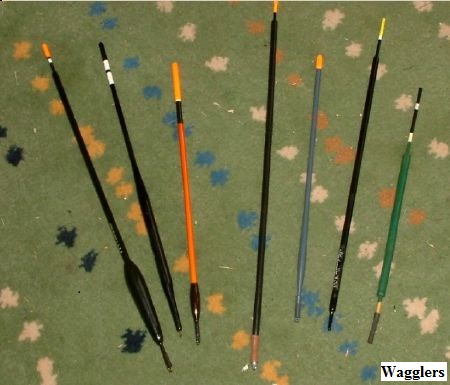 The floats in this photo are “wagglers” fished bottom end only and to be honest would be better used in Scotland on Lochs.
The floats in this photo are “wagglers” fished bottom end only and to be honest would be better used in Scotland on Lochs.
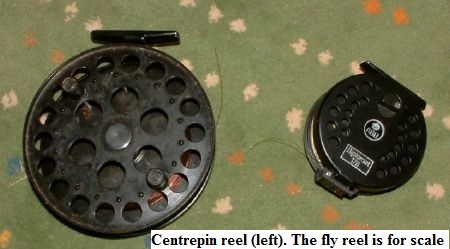
Richard "Burnie" Maurins ,57, born in Leicestershire and raised on the banks of the River Soar and Grand Union Canal, (well at the time they seemed exotic!), Richard has fished for everything with fins from minnow to marlin and has had letters and articles published in the Angling Times and The National Association of Specialist Anglers magazine. A former "specimen hunter", member of N.A.S.A. and the Tench-fishers group; Richard started fly fishing in Ireland and took a liking to it, mostly on the big southern reservoirs, but has always preferred moving water. He now lives in Inverkeilor, near Arbroath in Scotland with wife Mandy.

